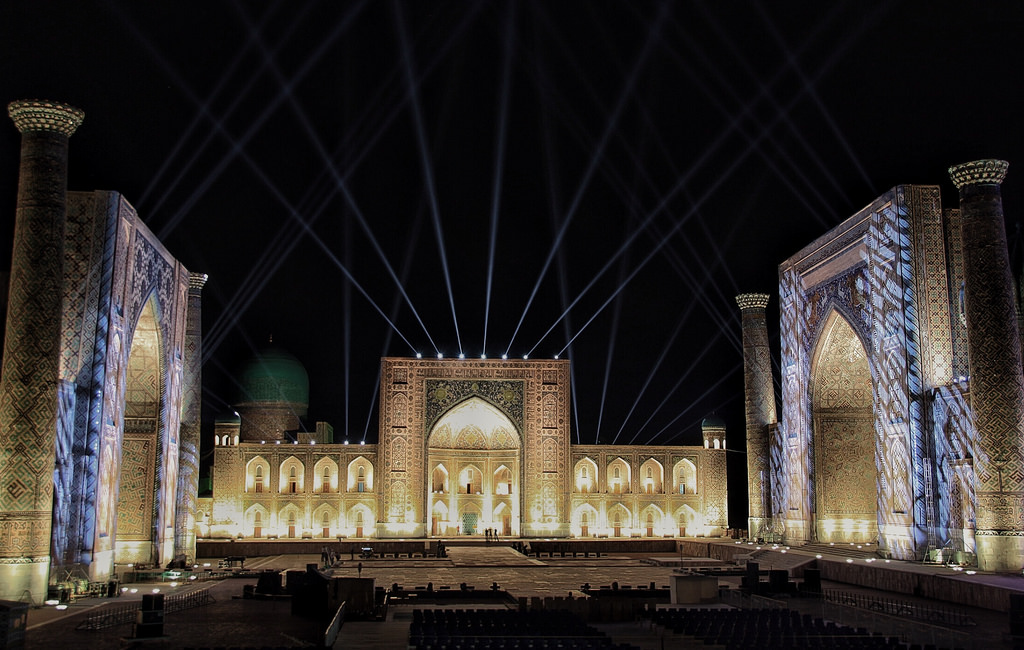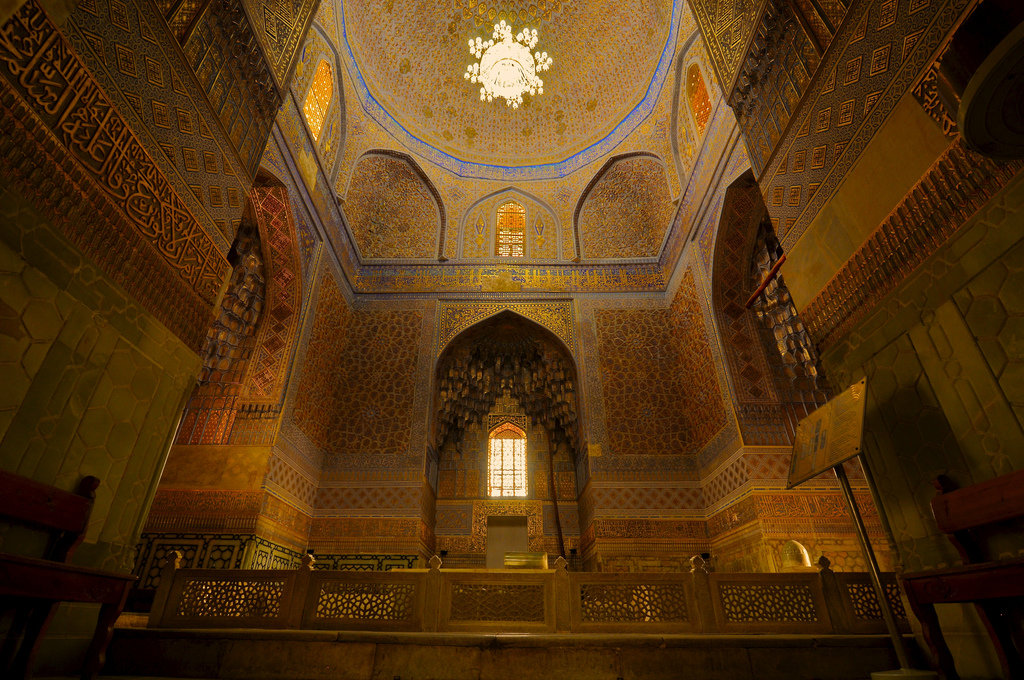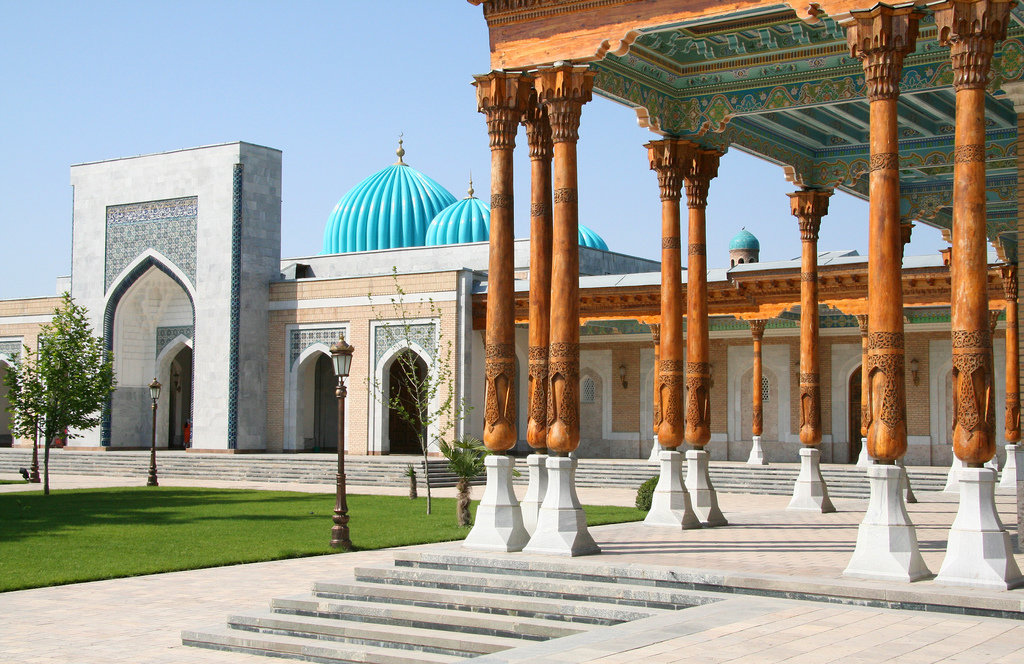In different centuries, Uzbekistan’s ancient cities played the main role on the Great Silk Road. But the title “the Heart of Great Silk Road” is owned by Samarkand.
Registan Square (A World Heritage Site). The centerpiece of the city and the symbol of Uzbekistan is the majestic Registan Square. Situated in the elevated part of the city, this square with an ensemble of three madrasahs was built about 600 years ago. In Samarkand they say that all roads lead to Registan. The huge portals, domes and minarets of Ulugbek madrasah, Sher-Dor madrasah, and Tilla-Kari madrasah can be seen from everywhere in the city.
Of three madrasahs in Registan Square, Ulugbek Madrasah is the oldest. As far back as Amir Temur’s rule, on Registan (“Sandy Place”) a huge domed shopping arcade was built near the town’s bazaar. In 1420, the structure was pulled down to make way for a madrasah designed by the famous architect Kavamaddin Shirazi from Hirat. The main façade is covered with splendid mosaic floral patterns made in islimi style, and has a tall portal decorated with astral patterns.

Bibi-Khanum Mosque (A World Heritage Site). The grandest structure of Amir Temur’s times is the chief Friday Mosque called Bibi-Khanum. Construction began in 1339, after Temur’s victorious campaign to India, and was completed in 1404. The best architects, craftsmen, stonemasons, and artists from Samarkand as well as from the countries Temur had subdued, laboured at the construction of the Mosque. Ninety Indian elephants were used to perform hard work at the site. During his stays in the capital between his military campaigns, Temur personally supervised the construction. In his absence, it was watched over by his wife Sarai-Mulk-Khanum, who had the title Bibi-Khanum, or “Senior Wife.”
Ulugbek’s Observatory (A World Heritage Site). In the outskirts of Samarkand, on Kukhak hill, stands Ulugbek’s Observatory, a unique historical and architectural monument. Having inherited the power over Movarounnahr from Amir Temur, his grandson Mirzo Ulugbek successfully combined royal duties with scientific activities. He is known worldwide as the founder of the famous Samarkand astronomic school. His crowning achievement, which brought him international fame, was the compilation of a star catalogue “Ziji jadidi Gurgani.”
Guri-Amir Mausoleum (A World Heritage Site). Guri Amir Mausoleum, Amir Temur’s burial-vault, is one of the best examples of medieval Oriental architecture and one of the most significant monuments of Temurides’ time. Its construction was initiated by Amir Temur in the autumn of 1404. The mausoleum was originally intended for Muhammad Sultan, Temur’s beloved grandson and successor, who had died in Iran in 1403. The place for internment of the prince was designated to be near Muhammad Sultan’s madrasah and khanaka, which had been built opposite the other during his lifetime.

Shahi-Zinda Necropolis (A World Heritage Site). Shahi-Zinda Necropolis is one of the most visually stunning architectural monuments of Amir Temur’s times in Samarkand. Initially the necropolis started at the end of the 9th century in the outskirts of Afrosiab, near the shrine of holy Kusam ibn Abbas, a cousin of the Prophet Mohammed. Yet mausoleums continued to appear near the sacred site as far as the mid-15th century. Kusam ibn Abbas was killed in a fight with pagans in Samarkand in the 7th century and was buried on the southeastern slope of the Afrosiab site.
The Ancient Settlement of Afrosiab (A World Heritage Site). The ancient settlement of Afrosiab is situated on the spurs of Chupan-Ata hills to the northeast of present-day Samarkand. According to the legend, it was here, on the banks of the river Siab, that the Turanian king and hero Afrosiab, a character of the folk epic “Shahnama,” founded the town that became the capital of Sogdiana.
Rukhabad Shrine (A World Heritage Site). The Rukhabad shrine is one of the earliest constructions that remained intact in Samarkand from the epoch of Amir Temur. It was constructed in the 14th century, precisely on the same axis as Amir Temur’s burial-vault. A magnificent shady avenue and a road paved with marble slabs used to connect these two constructions. The mausoleum was erected over the tomb of the well-known Samarkand mystic Sheikh Burhaniddin Sagarji, who was a member of a dervish order and spent his life in pilgrim wanderings. His died in China, but just before passing away, he asked his son to bury him in Samarkand.
Imam Al-Bukhori Complex. In Hortang village, located 7.5 miles from Samarkand, is one of the relics of the Muslim world, the Imam Al-Bukhori Memorial Complex. The outstanding Sunni theologian Imam Muhammad ibn Ismail Abu Abdallah Al-Bukhori is known as the author of the most authoritative book after the Koran, Al-Jami-al-Sahih, which is a collection of the most authentic hadiths, which are the Prophet Mohammed’s acts and sayings. Imam Al-Bukhori was born in Bukhara in 810. He was left an orphan at an early age, and as a child, he began to study theological sciences; most of all, he was interested in studying hadiths. At the age of ten, he was allowed to participate in the debates of theologians, who were amazed by his expressive reading and thorough interpretation of the Prophet’s hadiths.

Ishratkhana (A World Heritage Site). Suzangarian is home to one of the most refined buildings by Central Asian architects, the Ishratkhana mausoleum. Graceful and proportional, with neat decorations and a turquoise dome, it carries the name of “house of joy and pleasure.” A number of legends connect this building with Tamerlane, but the notice on the building tells us that it was built at the request of the wife of the governor of Samarkand at that time, Abu Said Habib Sultanbegim. Constructed in memory of their daughter, who died in her early years, it was later turned into the burial tomb for all women from the family tree of Tamerlane.


